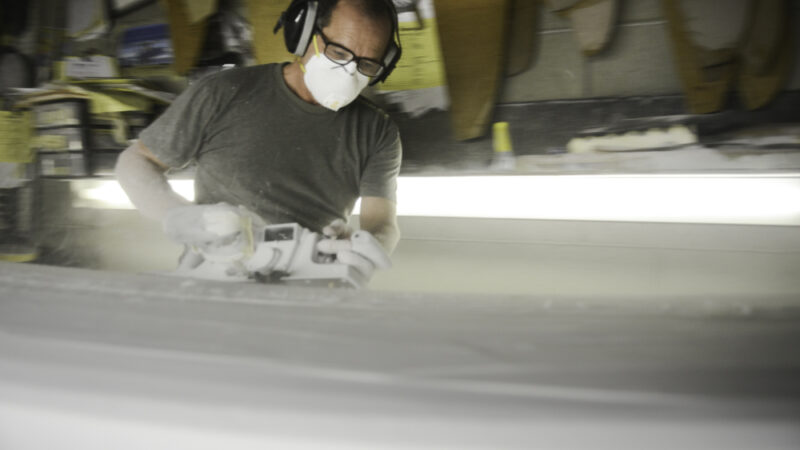
Evan Geiselman Psyches Up
© Corey Wilson
Isn’t it just the most primitive thing imaginable? That in this futuristic epoch where we bury ourselves in glowing portable screens and know with complete certainty if there’s going to be waves or not in the morning, we still have to apply a crude chemical compound to our surfboards?
For 50 years surfers have been buying these small bars of paraffin wax/coconut oil combos and applying it in criss-cross patterns to their surfboards. Inventors have tried to get us off the wax train with spray-on grip, full-deck traction pads and even textured fiberglass, but nothing works quite like the traditional surf wax.
So what’s the best way to wax your surfboard? Here are some things you have to know, do, and live by…
So what’s the best way to wax your surfboard?
Follow these simple steps for the perfect wax job:
-
Start with the base coat. Hold the bar at 45 degrees and drag it across the deck in thick lines, a dozen or so. Now rub it in small circles. Can you see beads forming? Perfect! Go from one rail to the other and then from one tail to the other. Don’t miss a spot.
-
Top coats are the more specific coats for water temperatures and need to be reapplied before a shred sesh. Apply the top coat in the same way you applied the base.
Things to Keep in Mind
Buy the right wax for the water temperature: hard wax for warm water, soft wax for cold water. Simple! But if you’re a base coat/top coat kinda surfer, you’ll choose a hard wax for the base and something stickier, which means softer, for the deck. A top coat only means you choose exactly what you need. Shop for top coats based on where you’re surfing. The wax will tell you what kind of water it’s for on the label.
What’s the difference between a combo or a single swipe? A base coat/top coat combo gives an exact grip. The base coat holds the top coat in place and stops it from rubbing off. Go for a single swipe and, after a few waves, you’ll soon notice wax-free areas on your deck. Applying a base is vital to a lasting finish, especially if you’re out on the water regularly or tearing it up with sick tricks. Base coats should last a while and only need to be applied to fresh boards or a board that you’ve totally stripped the wax from.
Removing Wax
Don’t worry, you don’t have to strip your board and reapply every time you’re about to head out to catch some waves. You’ll know you’ve got to strip it when the wax is dirty or you see it peeling off. Simply cover your board in sand, and leave it in the warm sun for like 10 minutes to let the wax melt. Then, take a wax comb and scrape all the wax off. If you find some annoying spots that you can’t get off, put wax remover on a rag and wipe it off.
Tools needed
To apply and remove surf wax properly, you’ll need the following tools:
-
Base coat.
-
Top coat.
-
Wax comb.
-
Wax remover.
Recommended Products
There are lots of surf wax products out there, but Sticky Bumps and Matunas use all-natural ingredients, which is nice for the environment and your hands. Sticky Bumps makes bars of base wax and specific water wax for warm/tropical or cool/cold water. Matunas also offers base and top coats in large packs so you can stock up.
When to Wax
The condition of your wax can be the difference between a make and a fail. I can’t think of anything more embarrassing or frustrating than cartwheeling down a wave because one of your feet slid off. Make it a rule to scrape all the wax off every month (let it loosen up a little in the sun but not for too long as fibreglass boards hate direct sunlight), clean it up with acetone, and reapply your base and top coats.
It’s also a good idea to apply surf wax before heading out for a surf trip. If you’re switching up the kind of water you’ll be ripping in, you’ll need to change the wax you use. Heading to tropical water after mostly surfing in the chilly waters at some of these California spots? Switch out the soft wax for hard wax so your entire trip isn’t ruined by a slippery board.
Methods of Board Waxing
It’s almost a rule, a law of surfing, that the best surfers have the best wax jobs. You might see a lot of surfers with thickened goop on their boards but go to a contest at the highest level, and you’ll see perfectly formed clean wax. Taking your wax job seriously is one of the basics of good surfing.
Some pros recommend rubbing the base wax in small circles to start, while others say to start with lines. Either way, you rub the wax well to work it into the surface of the board and get it smooth. Circular motion is good because it helps make sure you cover every part of the board. You don’t want your foot to find a wax-free spot in the middle of a wave. Beginner or pro, it’s not a good move.
Small circles keep you from creating dots of unwaxed spots across your board and give you those tiny bumps you want to help your feet get a good grip. A patient wax job is a good one.
Another difference in methods is board coverage. Some say you should coat the entire board in wax, while others suggest only covering areas where your feet will stand and where your chest will lay. Longboarders who plan to move around on the board definitely want to get the whole thing.
If you want to shred, you need grip. Love your wax.





Recent Comments